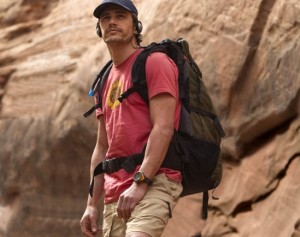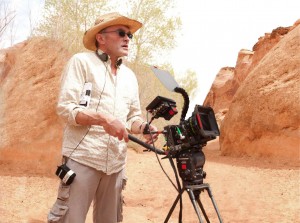 It’s been about 72 hours since I’ve seen Danny Boyle’s 127 Hours (opening Nov. 5) and I can’t stop thinking about it. You know how some experiences stay with you? This movie has clung to me the way Aron Ralston clung to life while stuck deep in a crevice in Utah’s Blue John Canyon.
It’s been about 72 hours since I’ve seen Danny Boyle’s 127 Hours (opening Nov. 5) and I can’t stop thinking about it. You know how some experiences stay with you? This movie has clung to me the way Aron Ralston clung to life while stuck deep in a crevice in Utah’s Blue John Canyon.
Adapted from his autobiography Between a Rock and a Hard Place, Hours recounts the 5+ days in 2003 that Ralston, an experienced canyoneer, spent alone and trapped after falling and having his right arm pinned by a boulder. Not having told anyone where he was going, Ralston (James Franco) knew it was up to him whether he lived or died there. He eventually freed himself by doing something most people probably wouldn’t have the physical or mental strength to do. It sounds grueling—and it is—but Franco, director Danny Boyle and his production team have managed to make an incredibly moving and uplifting film about it all.
 Let’s start with Franco. Holding the audience’s attention in every frame of a feature film all by himself has a difficulty level of at least 9.85 but the actor pulls it off with aplomb. He’s charming, raw, and even funny as he tracks Ralston through frustration, delirium, and Hell-no-I-won’t-die-here determination, giving life and energy to what are essentially monologues (well-written by Simon Beaufoy). Though Franco has delivered award-winning performances before in Milk and the James Dean TV movie, his work here should take the already busy actor’s career to new heights.
Let’s start with Franco. Holding the audience’s attention in every frame of a feature film all by himself has a difficulty level of at least 9.85 but the actor pulls it off with aplomb. He’s charming, raw, and even funny as he tracks Ralston through frustration, delirium, and Hell-no-I-won’t-die-here determination, giving life and energy to what are essentially monologues (well-written by Simon Beaufoy). Though Franco has delivered award-winning performances before in Milk and the James Dean TV movie, his work here should take the already busy actor’s career to new heights.
The movie’s impact is also helped along by striking cinematography from Anthony Dod Mantle and Enrique Chediak. The blue skies, brown earth, Ralston’s red T-shirt with a bright yellow sunflower combine to create vibrant tableaux. Even as Ralston is stuck in what could’ve been his death trap, he caresses the rocks around him and reaches his leg towards sunlight, heartbreaking gestures of appreciation for the undeniable beauty around him. At one point, there’s a long continuous shot that starts in the narrow trench with Ralston and slowly pulls out to a wide aerial view of the canyons that’s breathtaking.
 And then there’s Boyle. Working with several of his Oscar-winning team members from Slumdog Millionnaire, the director has, in his own words (see more below), made “an action movie where the hero can’t move.” The movie begins with the kind of kinetic energy we saw in the street scenes in Slumdog, full of speed and movement. Ralston is shown as an adrenaline junkie, never stopping in one place for long, until nature, the thing he loves most, stops him cold and forces him to re-evaluate his path in life. The movie’s momentum could have come to a crashing halt at this point but Boyle found a way for us to continue on Ralston’s journey by taking us into Ralston’s mind as he reminisces about the people he loves most. I didn’t realize how deeply entrenched I was with Ralston in that canyon until the moment help finally comes after he climbs out and encounters other hikers. I wept, hard, shaking with tears of relief for several long minutes, exhaling and realizing my heart had been in my throat.
And then there’s Boyle. Working with several of his Oscar-winning team members from Slumdog Millionnaire, the director has, in his own words (see more below), made “an action movie where the hero can’t move.” The movie begins with the kind of kinetic energy we saw in the street scenes in Slumdog, full of speed and movement. Ralston is shown as an adrenaline junkie, never stopping in one place for long, until nature, the thing he loves most, stops him cold and forces him to re-evaluate his path in life. The movie’s momentum could have come to a crashing halt at this point but Boyle found a way for us to continue on Ralston’s journey by taking us into Ralston’s mind as he reminisces about the people he loves most. I didn’t realize how deeply entrenched I was with Ralston in that canyon until the moment help finally comes after he climbs out and encounters other hikers. I wept, hard, shaking with tears of relief for several long minutes, exhaling and realizing my heart had been in my throat.
I imagine that those of you familiar with the story will want to know how graphic those scenes are depicting what Ralston did to survive. I couldn’t watch but did observe the reactions of the people around me. Judging by that and the sound effects, the scenes are quite disturbing. But they don’t last long and shouldn’t deter you from seeing this amazing film.
Nerd verdict: Tense, gripping Hours
I attended a screening sponsored by Variety which had Boyle, screenwriter Beaufoy and producer Christian Colson doing Q&A afterward. Some highlights from the discussion:
- Boyle first approached Ralston in 2006 about doing the film but Ralston had wanted to make it as a documentary back then.
- Once Ralston came on board, he shared with Boyle the videotapes he made in the canyon for loved ones when he thought he would never see them again. Boyle thought they’d be hard to watch but was amazed by how dignified and lacking in self pity the messages were.
- Because the story is mostly internal monologue, Beaufoy didn’t think it could be adapted into a movie. Boyle figured out how to make it cinematic through the video clips Ralston makes and his memories, when he talks to his family back home.
- Ralston is extremely detailed. When the filmmakers sent him a 60-page script, he sent back 70-page notes.
- Ralston genuinely believes the accident was a blessing because it made him stop and re-think his life.
- Shooting was done in the canyon where the accident happened, with close-ups done on a set in a warehouse in Utah.
- The first test screening was done in New Jersey, where the audience stood up, pumped their arms in the air and yelled “YES!” at the end. This mitigated the painful experience for Ralston, who was watching it for the first time.
Photos: Chuck Zlotnick






11 Comments
Bailey
October 25, 2010 at 12:39 amAlthough I haven’t seen this movie, I am reminded of how Tom Hank’s Oscar nominated performance in CASTAWAY affected you…….”it was amazing to see ONE actor brilliantly capture an audience in the palm of his hands…all by himself”….this is what I am expecting of Franco.
Pop Culture Nerd
October 25, 2010 at 2:39 pmYou have a GREAT memory, Bailey! I didn’t think about Cast Away while watching this but the comparison is apt.
le0pard13
October 25, 2010 at 1:02 pmThis is one of the films I’m most anxious to see this Fall. Great post on this, Elyse. Thanks for this.
Pop Culture Nerd
October 25, 2010 at 2:42 pmI’m glad this is on your list. It’s better than Slumdog, though admittedly I didn’t love that movie.
le0pard13
October 25, 2010 at 2:45 pmWe’re in agreement with that, too 😉
Reader#9
October 25, 2010 at 3:41 pmI read the book a while back. Still haunts me and can only imagine how much the impact will be onscreen. But, I will go see it even though I probably won’t react like I’m from New Jersey. No, not picking on Jersey.
Shell Sherree
October 25, 2010 at 4:25 pmMy eyes were misting up reading your review, PCN, so we can guess what it’s going to be like watching the movie!
Paulette
October 25, 2010 at 5:03 pmYour REVIEW had me on the edge of my seat…can’t wait to see the movie. I fear I will not have the presence of mind to look away, however, during the disturbing scenes; I have never been able to do that even when I know I will feel ill and eventually must leave the theater for a few moments.
Pop Culture Nerd
October 26, 2010 at 4:10 pmReader#9—Would be interested in hearing how the book compares to the movie. I didn’t react like “the New Jersey people” (Boyle’s words) but my reaction was no less cathartic.
Shell—Oh, thanks, Shell. Bring tissues!
Paulette—Thank you. I didn’t realize my review was so suspenseful! If you do look during those scenes, you’ll have to describe them to me.
jenn
November 15, 2010 at 4:28 pmWow. I have to see this, though my mind is running rampant (and making me nauseous) imagining what he has to do to survive.
Thanks for putting this movie on my list – I hadn’t heard of it until you mentioned it.
Pop Culture Nerd
November 16, 2010 at 1:33 pmYou help settle a debate between my husband and me. He’s been recommending the movie to friends but blatantly giving away the climactic moment, assuming everyone knows about it because it was in the news. I say we shouldn’t assume that because it happened 7 years ago and people can’t be aware of everything in the news.
I’d be very interested to hear your thoughts after you see it!